

www.farmboyzimsflightsims.com
FBZFS
Thanks For The Visit !
FBZ's Fast Flight's
Grand Canyon
KGCN to 61B
Grand Canyon
KGCN to 61B
Home
Product Reviews
Freeware Reviews
Press Releases
Forum
Articles
Screenshot Gallery
Downloads
Multiplayer Server
TeamSpeak
Tutorials
General Store
Aircraft of the World
Weather
Maps
Links
Certificates
Product Reviews
Freeware Reviews
Press Releases
Forum
Articles
Screenshot Gallery
Downloads
Multiplayer Server
TeamSpeak
Tutorials
General Store
Aircraft of the World
Weather
Maps
Links
Certificates
The Grand Canyon National Park, one of the seven Natural Wonders of the World. One can certainly see why when you take a virtual flight through this amazing landmark!
A number of processes combined to create the views that you see in todays Grand Canyon. The most powerful force to have an impact on the Grand Canyon is erosion, primarily by water (and ice) and second by wind. Other forces that contributed to the Canyon's formation are the course of the Colorado River itself, vulcanism (no, Spock had nothing to do with this!), continental drift and slight variations in the earths orbit which in turn causes variations in seasons and climate.
Water seems to have had the most impact. When it does rain the water tends to come down in torrents which only adds to the problem. Now you've got lots of water, no place for it to go, but down to the Colorado River. The result is frequently a flash flood roaring down a side canyon that can move boulders and massive amounts of soil. This mass that moves down a side canyon during a flash flood is more like a fast flowing concrete than water and it can be very dangerous.
A number of processes combined to create the views that you see in todays Grand Canyon. The most powerful force to have an impact on the Grand Canyon is erosion, primarily by water (and ice) and second by wind. Other forces that contributed to the Canyon's formation are the course of the Colorado River itself, vulcanism (no, Spock had nothing to do with this!), continental drift and slight variations in the earths orbit which in turn causes variations in seasons and climate.
Water seems to have had the most impact. When it does rain the water tends to come down in torrents which only adds to the problem. Now you've got lots of water, no place for it to go, but down to the Colorado River. The result is frequently a flash flood roaring down a side canyon that can move boulders and massive amounts of soil. This mass that moves down a side canyon during a flash flood is more like a fast flowing concrete than water and it can be very dangerous.
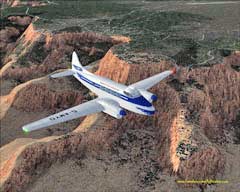
After erosion by liquid water the next most powerful force is probably its solid form, ice. In the colder months, especially on the north rim, water seeps into cracks between the rocks. These cracks can be caused by seismic activity, or by the constant soaking and drying of the rocks. When the water freezes it expands and pushes the rocks apart and widens the cracks. Once the ice had pushed the rocks off the edge and the water in the flash floods has carried them down to the river, then the Colorado itself takes over. The erosive action of the Colorado has been severely constrained by the building of the Glen Canyon Dam, which ended the annual spring floods, but there is still a lot of water flowing relatively quickly through a very narrow gorge. Before building the dam the Colorado River had spring floods that would exceed a flow rate of 100,000 CFS. All of that snow melting in the Colorado Rockies came pouring down through the Grand Canyon in May and June, every year, like clock-work. These spring floods were considerably larger than todays "trickle" of 8,000-10,000 CFS at low water and even the 20,000 CFS peak flow rates.
The Colorado's spring floods used to carry away all of the debris that was deposited in the main channel by the flash floods, but todays mediocre flow rates have a tough time doing the job. It still gets done to some extent, it just takes a lot longer. In the process of moving the rocks and sediment down the river to the Pacific Ocean the bed of the river is scoured by all of this fast moving debris which slowly eats away at the banks and bed of the river. This causes the river to widen and cut down deeper into the lower rock layers. Another cause for the slowing of the erosive force of the Colorado River is the fact that it is now trying to cut through harder granites and schists found at the bottom of the Canyon instead of the softer limestones, sandstones and shales near the top. This rock takes a lot longer to erode and a slower moving river means it takes even longer. I have seen some pictures of the Colorado River where it meets the Pacific Ocean, and I was amazed at what I saw. It looked like mud flats with a small creek going through it! Quite a bit of water is utilized along the way, as it snakes on down out of the Rockies, for irrigation and other needs.
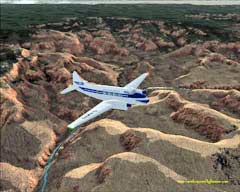
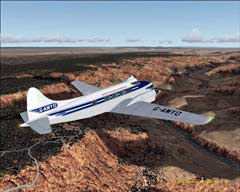
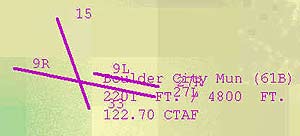
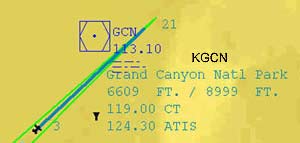
My flight started at the small airport of the Grand Canyon National Park (KGCN), and although I had a flight plan, I really didn't follow it that much! There were to many things to see in this wonderous area! believe me when I say to you that it is easy to lose track of time while flying in this region, and if you're a
"screen shooter", be prepared to give the "Print screen" key a serious workout! I usually post a pic of the route that I take, but not this time! All you would see is the red line of the flight path looping, curving, and generally meandering all over the place! the best times to fly over the canyon are at sunrise or Sunset, for this affords you some outstanding views of the canyon in shadows, and really brings the entire flight experience to an open mouthed level of awe at what you are beholding! I can't imagine anyone missing out on this region, but if you have, take a gander at some of the screenshots and I bet you'll hop into your favorite sightseeing aircraft and head to Arizona! Here's a couple of links to Avsim for some scenery enhancments for the Grand Canyon:
Grand Canyon National Park NED Terrain Mesh and Grand Canyon Thermals and Tour plan. You need to be a registered member at Avsim to download these files. Enjoy!!!
Grand Canyon National Park NED Terrain Mesh and Grand Canyon Thermals and Tour plan. You need to be a registered member at Avsim to download these files. Enjoy!!!















